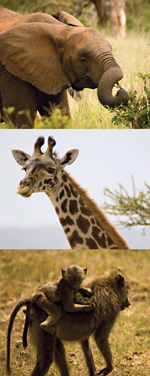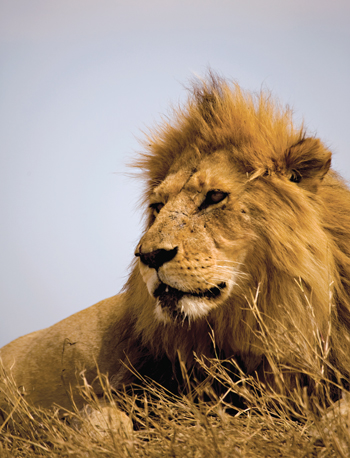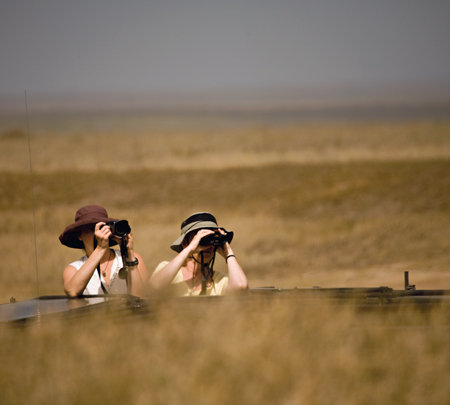Sitting on my elevated tent deck, a white-crowned shrike and I shared an expansive view of the Serengeti. When the elegant bird flew off, the vast beauty of Tanzania was, for a moment, mine alone to enjoy.
My adventure had begun several days earlier in Arusha, a bustling town on the eastern edge of the Great Rift Valley, whose location serves as a convenient jumping-off place for several Tanzanian journeys, including a trek to the forested slopes of famed Mount Kilimanjaro. First, though, I visited several elementary schools to see the work of Kids of Kilimanjaro, a lunch program sponsored by a California nonprofit a family friend started three years ago. The children were engaging and bright and greeted me with welcoming smiles.
Then I was off to Kilimanjaro for a hike through the rain forest that surrounds the base of this massive mountain known as the “Rooftop of Africa.” A guide led the way, naming the plants and animals we passed on the way to our destination—a double waterfall where black-and-white colobus monkeys swing from wild magnolia trees. Along our path, we encountered a group of trekkers who had ventured to the 19,340-foot summit. They were beaming with accomplishment.

Kilimanjaro was a warm-up for the next leg—a 10-day safari in search of migrating wildlife. We traded in our hiking boots for the relative comfort of a bouncy Land Cruiser whose roof peeled back for open-air picture taking. As we made our way southeast on the two-hour drive from Arusha to Tarangire National Park, I spotted my first wild animal— a giraffe ambling across the plain with fluid elegance. Our resting spot for two nights was Tarangire Tree Tops, a luxury tent camp where I was greeted by an elephant who stood stubbornly between me and my quarters. Thankfully, I was with a guard who wisely suggested another route. As we detoured to my tent, a loud snap crackled through the camp. I turned to look behind me and saw that my elephant friend, apparently wanting better access to its leafy lunch, had taken down a whole tree with one powerful whack of his foot.
In the fading evening light, my treetop perch provided a view of the darkening plains. Huge acacia trees were silhouetted like umbrellas. Waves of purple morning glories peppered amid sycamore figs and baobab trees accented the light of the setting sun. I slept well and woke rested and ready for my first game drive.
Tanzania has more than 1,000 species of birds, many of them so colorful they look like tropical fish with wings. As we drove, some of them flew in front of the Land Cruiser, riding the draft of the vehicle like living hood ornaments. The March-to-May rainy season had just ended and the animals were out in force. We stopped for elephants, zebras, impalas, giraffes and baboons.
From Tarangire we motored on to Lake Manyara National Park, where a huge water buffalo met us at the park gate. It grunted loudly at our interruption of its meal. I imagined it might be saying “karibu”—welcome in Swahili. We drove deeper into the park, passing herds of corpulent hippos lazing in the mud. In the distance, a fluorescent ribbon of flamingos ringed the shore.
The next day more animals awaited us at Ngorongoro Crater, a 2,000-foot-deep caldera reachable by a sinuous mountain road. From above, Ngorongoro appears void of life, but as we descended to the crater floor we saw that it was teeming with creatures and activity—giant tusked elephants, ostriches, wildebeests and warthogs. Black-maned lions patrolled the grasslands and flamingos clustered by the thousands around the crater’s Lake Magadi. Amid this dramatic backdrop, our guide surprised us with a formal picnic prepared by our host, Serena Safari Lodge. As I ate at a long table dressed in white linens and a vibrant Masai fabric runner and watched toque-topped chefs work in the background, I pretended it was my birthday, because an afternoon like this must be savored as a special occasion.
Our last stop: the Serengeti—7,650 square miles of plains and home to Africa’s great wildlife migrations. The great herds of beasts were impressive, to say the least, but it was a lone lion that provided the most memorable image. Sitting atop a rock—a solitary throne—and casually surveying the arid terrain below, he seemed aware of his majestic strength.
We spent our final night in Kirawira Camp, where the exquisite tents share the night with dik-dik, genet cat, and yes, perhaps a wandering water buffalo or curious lion. Daybreak arrived with the sweet chirping of birds and a gentle “good morning” from a staff member. He held a tray with a silver teapot and a china cup. It was a lovely way to begin a day—and to say farewell to Africa.


